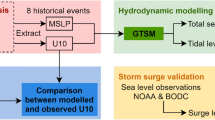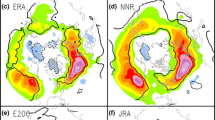Abstract
This study examines the tropical storms simulated in the Modern-Era Retrospective analysis for Research and Applications (MERRA) global atmospheric reanalysis for the recent 12 years (1998–2009), focusing on the tropical storm activity over the Northwestern Pacific. For validation, the International Best Track Archive for Climate Stewardship (IBTrACS) dataset is used as an observational counterpart. Climatological-mean features of the tropical storm genesis, tracks and their maximum intensity are the primary interests in this study. Regarding the genesis location of tropical storms, MERRA is reasonable in resolving major development regions over the South China Sea and the Northwestern Pacific close to the Philippines. The seasonal variation of the number of storms is also reproduced in a realistic way in MERRA, with peak values occurring from July to September. In addition, MERRA tends to reproduce the observed interannual variation of the number of tropical storms during the 12-years, though with a limited accuracy. The simulated paths toward higher latitudes are also reasonable in MERRA, where the reanalysis corresponds well with the observations in resolving frequent paths of westward moving storms and recurving storms toward the northeast. Regarding the intensity, MERRA captures the linear relationship between the minimum center pressure and the maximum wind speed near the surface at the maximum development. Some discrepancies from the observed features are found in the reanalysis, such as less frequent development of storms over the South China Sea and less frequent paths over this region. The reanalysis also does not attain the observed maximum intensity for the resolved tropical storms, particularly underestimating the center pressure. These deficiencies are likely related to limitations in the horizontal resolution and the parameterized physics of the data assimilation system.
Similar content being viewed by others
References
Bosilovich, M. G., J. Chen, F. R. Robertson, and R. F. Adler, 2008: Evaluation of Global Precipitation in Reanalyses. J. Appl. Meteor. Climatol., 47, 2279–2299.
Bloom, S., L. Takacs, A. DaSilva, and D. Ledvina, 1996: Data assimilation using incremental analysis updates. Mon. Wea. Rev., 124, 1256–1271.
Bosilovich, M. G., F. R. Robertson, and J. Chen, 2011: Energy and water budgets in MERRA. J. Climate, Submitted.
Camargo, S. J., and S. E. Zebiak, 2002: Improving the detection and tracking of tropical cyclones in atmospheric general circulation models. Wea. Forecasting, 17, 1152–1162.
Chou, M. -D., and M. J. Suarez, 1999: A Solar Radiation Parameterization for Atmospheric Studies. NASA Technical Report Series on Global Modeling and Data Assimilation 104606, 15, 40 pp.
___ M. J. Suarez, X. Z. Liang, and M. M.-H. Yan, 2001: A Thermal Infrared Radiation Parameterization for Atmospheric Studies. NASA Technical Report Series on Global Modeling and Data Assimilation 104606, 19, 56 pp
Garcia, R. R. and B. A. Boville, 1994: Downward control of the mean meridional circulation and temperature distribution of the polar winter stratosphere, J. Atmos. Sci., 51, 2238–2245.
Kalnay, E., and Coauthors, 1996: The NCEP/NCAR 40-Year Reanalysis Project. Bull. Amer. Meteor. Soc., 77, 437–471.
Kanamitsu, M., W. Ebisuzaki, J. Woolen, S.-K. Yang, J. J. Hnilo, M. Fiorino, and G. L. Potter, 2002: NCEP-DOE AMIP-II Reanalysis (R-2). Bull. Amer. Meteor. Soc., 83, 1631–1643.
Kim, H.-S., J.-H. Kim, C.-H. Ho, and P.-S. Chu, 2011: Pattern classification of typhoon tracks using the fuzzy c-means clustering method, J. Climate, 24, 488–508.
Knapp, K. R. and M. C. Kruk, 2010: Quantifying interagency differences in tropical cyclone best-track wind speed estimates, Mon. Wea. Rev., 138, 1459–1473.
—, D. H. Levinson, H. J. Diamond, and C. J. Neumann, 2010: The International Best Track Archive for Climate Stewardship (IBTrACS): Unifying tropical cyclone best track data. Bull. Amer. Meteor. Soc., 91, 363–376.
Koster, R. D., M. J. Suárez, A. Ducharne, M. Stieglitz, and P. Kumar, 2000: A catchment-based approach to modeling land surface processes in a GCM, Part 1, Model Structure. J. Geophys. Res., 105, 24809–24822.
Lin, S.-J., 2004: A vertically Lagrangian finite-volume dynamical core for global models. Mon. Wea. Rev., 132, 2293–2307.
Lock, A. P., A. R. Brown, M. R. Bush, G. M. Martin, and R. N. B. Smith, 2000: A new boundary layer mixing scheme. Part I: Scheme description and single-column model tests. Mon. Wea. Rev., 138, 3187–3199.
Louis, J., M. Tiedtke, and J. Geleyn, 1982: A short history of the PBL parameterization at ECMWF. Proc. ECMWF Workshop on Planetary Boundary Layer Parameterization, Reading, United Kingdom, ECMWF, 59–80.
McFarlane, N. A., 1987: The effect of orographically excited gravity wave drag on the general circulation of the lower stratosphere and troposphere. J. Atmos. Sci., 44, 1775–1800.
Moorthi, S., and M. J. Suarez, 1992: Relaxed Arakawa-Schubert, A Parameterization of Moist Convection for General-Circulation Models. Mon. Wea. Rev. 120, 978–1002.
Onogi, K., and Coauthors, 2007: The JRA-25 Reanalysis. J. Meteor. Soc. Japan, 85, 369–432.
Rienecker, M. M., and Coauthors, 2008: The GEOS-5 Data Assimilation System — Documentation of Versions 5.0.1, 5.1.0, and 5.2.0. NASA Tech. Rep. Series on Global Modeling and Data Assimilation Vol. 27, 101 pp.
—, and Coauthors, 2011: MERRA — NASA’s Modern-Era Retrospective Analysis for Research and Applications, J. Climate, Submitted.
Saha, S., and Coauthors, 2010: The NCEP Climate Forecast System Reanalysis. Bull. Amer. Meteor. Soc., 91, 1015–1057.
Uppala, S., and Coauthors, 2005: The ERA-40 Re-Analysis. Quart. J. Roy. Meteor. Soc., 131, 2961–3012.
Wu, W.-S., R. J. Purser, and D. F. Parrish, 2002: Three-dimensional variational analysis with spatially inhomogeneous covariances. Mon. Wea. Rev., 130, 2905–2916.
Author information
Authors and Affiliations
Corresponding author
Rights and permissions
About this article
Cite this article
Lee, MI., Schubert, S.D. & Kim, D. Representation of tropical storms in the northwestern pacific by the Modern-Era Retrospective analysis for research and applications. Asia-Pacific J Atmos Sci 47, 245–253 (2011). https://doi.org/10.1007/s13143-011-0013-z
Received:
Revised:
Accepted:
Published:
Issue Date:
DOI: https://doi.org/10.1007/s13143-011-0013-z




